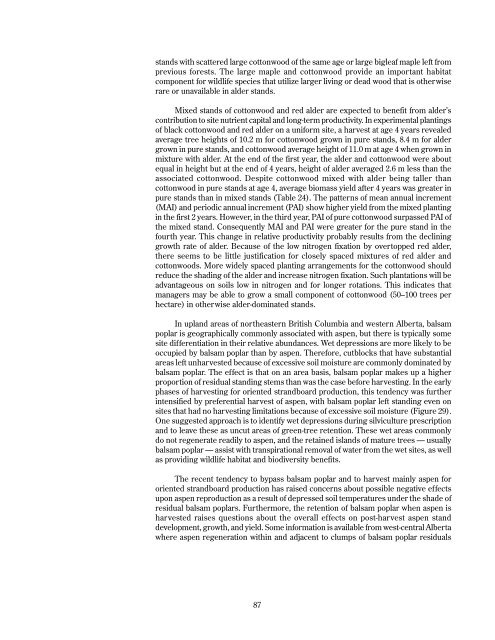FRDA Report: Black Cottonwood and Balsam Poplar Managers ...
FRDA Report: Black Cottonwood and Balsam Poplar Managers ...
FRDA Report: Black Cottonwood and Balsam Poplar Managers ...
Create successful ePaper yourself
Turn your PDF publications into a flip-book with our unique Google optimized e-Paper software.
st<strong>and</strong>s with scattered large cottonwood of the same age or large bigleaf maple left from<br />
previous forests. The large maple <strong>and</strong> cottonwood provide an important habitat<br />
component for wildlife species that utilize larger living or dead wood that is otherwise<br />
rare or unavailable in alder st<strong>and</strong>s.<br />
Mixed st<strong>and</strong>s of cottonwood <strong>and</strong> red alder are expected to benefit from alder’s<br />
contribution to site nutrient capital <strong>and</strong> long-term productivity. In experimental plantings<br />
of black cottonwood <strong>and</strong> red alder on a uniform site, a harvest at age 4 years revealed<br />
average tree heights of 10.2 m for cottonwood grown in pure st<strong>and</strong>s, 8.4 m for alder<br />
grown in pure st<strong>and</strong>s, <strong>and</strong> cottonwood average height of 11.0 m at age 4 when grown in<br />
mixture with alder. At the end of the first year, the alder <strong>and</strong> cottonwood were about<br />
equal in height but at the end of 4 years, height of alder averaged 2.6 m less than the<br />
associated cottonwood. Despite cottonwood mixed with alder being taller than<br />
cottonwood in pure st<strong>and</strong>s at age 4, average biomass yield after 4 years was greater in<br />
pure st<strong>and</strong>s than in mixed st<strong>and</strong>s (Table 24). The patterns of mean annual increment<br />
(MAI) <strong>and</strong> periodic annual increment (PAI) show higher yield from the mixed planting<br />
in the first 2 years. However, in the third year, PAI of pure cottonwood surpassed PAI of<br />
the mixed st<strong>and</strong>. Consequently MAI <strong>and</strong> PAI were greater for the pure st<strong>and</strong> in the<br />
fourth year. This change in relative productivity probably results from the declining<br />
growth rate of alder. Because of the low nitrogen fixation by overtopped red alder,<br />
there seems to be little justification for closely spaced mixtures of red alder <strong>and</strong><br />
cottonwoods. More widely spaced planting arrangements for the cottonwood should<br />
reduce the shading of the alder <strong>and</strong> increase nitrogen fixation. Such plantations will be<br />
advantageous on soils low in nitrogen <strong>and</strong> for longer rotations. This indicates that<br />
managers may be able to grow a small component of cottonwood (50–100 trees per<br />
hectare) in otherwise alder-dominated st<strong>and</strong>s.<br />
In upl<strong>and</strong> areas of northeastern British Columbia <strong>and</strong> western Alberta, balsam<br />
poplar is geographically commonly associated with aspen, but there is typically some<br />
site differentiation in their relative abundances. Wet depressions are more likely to be<br />
occupied by balsam poplar than by aspen. Therefore, cutblocks that have substantial<br />
areas left unharvested because of excessive soil moisture are commonly dominated by<br />
balsam poplar. The effect is that on an area basis, balsam poplar makes up a higher<br />
proportion of residual st<strong>and</strong>ing stems than was the case before harvesting. In the early<br />
phases of harvesting for oriented str<strong>and</strong>board production, this tendency was further<br />
intensified by preferential harvest of aspen, with balsam poplar left st<strong>and</strong>ing even on<br />
sites that had no harvesting limitations because of excessive soil moisture (Figure 29).<br />
One suggested approach is to identify wet depressions during silviculture prescription<br />
<strong>and</strong> to leave these as uncut areas of green-tree retention. These wet areas commonly<br />
do not regenerate readily to aspen, <strong>and</strong> the retained isl<strong>and</strong>s of mature trees — usually<br />
balsam poplar — assist with transpirational removal of water from the wet sites, as well<br />
as providing wildlife habitat <strong>and</strong> biodiversity benefits.<br />
The recent tendency to bypass balsam poplar <strong>and</strong> to harvest mainly aspen for<br />
oriented str<strong>and</strong>board production has raised concerns about possible negative effects<br />
upon aspen reproduction as a result of depressed soil temperatures under the shade of<br />
residual balsam poplars. Furthermore, the retention of balsam poplar when aspen is<br />
harvested raises questions about the overall effects on post-harvest aspen st<strong>and</strong><br />
development, growth, <strong>and</strong> yield. Some information is available from west-central Alberta<br />
where aspen regeneration within <strong>and</strong> adjacent to clumps of balsam poplar residuals<br />
87

















